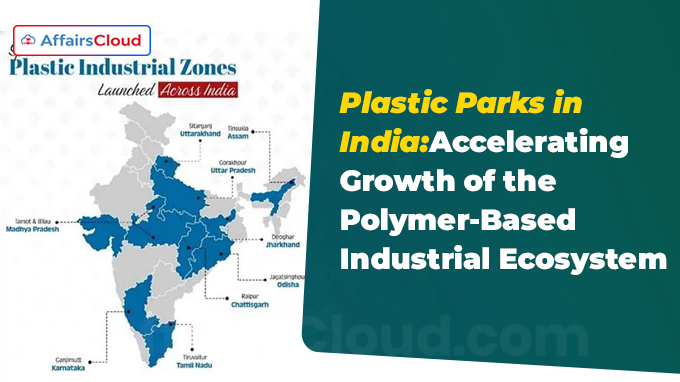 The Department of Chemicals and Petro-Chemicals under Ministry of Chemicals and Fertilizers is implementing the Scheme for Setting up of Plastic Parks under the umbrella scheme of New Scheme of Petrochemicals, to focus on developing Plastic Parks equipped with state-of-the-art infrastructure and common facilities.
The Department of Chemicals and Petro-Chemicals under Ministry of Chemicals and Fertilizers is implementing the Scheme for Setting up of Plastic Parks under the umbrella scheme of New Scheme of Petrochemicals, to focus on developing Plastic Parks equipped with state-of-the-art infrastructure and common facilities.
- India stands 12th in the world export of plastics, as per the 2022 World Bank estimates. It has experienced significant growth from 8.2 million thousand USD in 2014 to an estimated 27 million thousand USD in 2022.
Key Highlights:
i.Under the above scheme, the Government of India provides financial assistance of up to 50% of the project cost, with a maximum limit of Rs.40 crores per project.
ii.The following are the objectives of the scheme:
- Increase the competitiveness, polymer absorption capacity and value addition in the domestic downstream plastic processing industry.
- Increase investments in the sector through additions in capacity and production, facilitation to ensure value addition and increase in exports.
- Achieve environmentally sustainable growth through innovative methods.
- Adopt a cluster development approach to achieve the above objectives, leveraging the benefits of resource optimization and economies of scale.
Government Initiatives for promoting Plastic Production in India:
i.Centres of Excellence (CoE): To promote the research and development in polymer and plastics the department has established 13 CoE in various national level institutes.
ii.Skilling of Workforce: Central Institute of Petrochemical Engineering and Technology is conducting many short term and long-term courses in Plastics processing and Technology to cater to the skilling requirement of the industry.
Government Steps for Sustainable Growth of India’s Plastic Industry:
i.The Extended Producer Responsibility (EPR) Regulations for plastic packaging set rules for reusing, recycling, and using recycled materials. They help ensure proper waste management and ban certain single-use plastics to reduce pollution.
ii.The Hazardous Waste Management Rules seek to ensure proper disposal of hazardous chemicals and promote waste minimization and resource recovery.
iii.The government promotes a circular economy in the plastic industry by encouraging recycling and use of biodegradable alternatives. It also supports events and exhibitions to showcase new technologies, machines, and products made from recycled materials.
iv.India works with global bodies like the World Trade Organization (WTO) and United Nations Environment Programme (UNEP) to follow international sustainability standards. It also takes part in International Organization for Standardization (ISO) meetings to help set global standards for plastic products.
Process of setting up a Plastic Park:
i.To set up Plastic Parks, the Department of Chemicals and Petrochemicals invites initial proposals from state governments, including location and cost details.
ii.After getting in-principle approval from Scheme Steering Committee, the state agency must submit a Detailed Project Report (DPR), which is reviewed for final approval based on project viability.
iii.The following 10 Plastic Parks have been approved so far in different States:
| 1. Tamot, Madhya Pradesh | 2. Jagatsinghpur, Odisha |
| 3. Tinsukia, Assam | 4. Bilaua, Madhya Pradesh |
| 5. Deoghar, Jharkhand | 6. Tiruvallur, Tamil Nadu |
| 7. Sitarganj, Uttarakhand | 8. Raipur, Chhattisgarh |
| 9. Ganjimutt, Karnataka | 10. Gorakhpur, Uttar Pradesh |
About Ministry of Chemicals and Fertilizers:
Union Minister – Jagat Prakash Nadda (Constituency – Rajya Sabha, Gujarat)
Union Minister of State – Anupriya Patel (Constituency – Mirzapur, Uttar Pradesh)
Departments – Chemicals & Petro-Chemicals, Fertilizers and Pharmaceuticals




